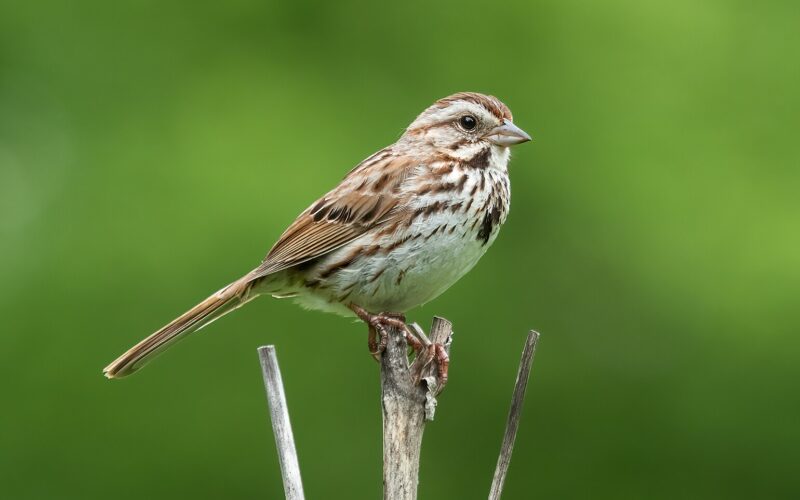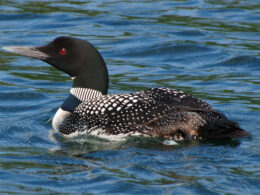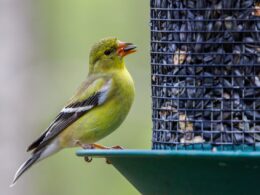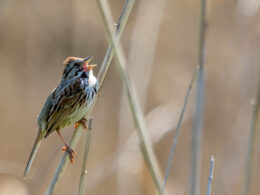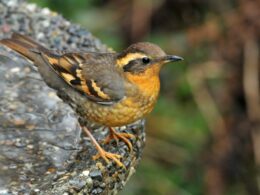Last Updated on January 18, 2024 by Greg Gillson
Are you thinking of joining the ranks of those that feed birds in Pennsylvania in winter? You are sure to enjoy it!
This article tells why and how to feed winter birds. Plus, it includes a list, with photos and brief descriptions, of birds that come to feeders in Pennsylvania. It tells exactly what foods and kind of feeders attracts each species of bird.
Winters in Pennsylvania are cold. Snow on the ground is expected. Blizzards and ice are frequent. If it is above freezing, then rain and fog are in the forecast. It is colder and snowier in the northwest along Lake Erie. It is a bit warmer and drier in the southeast near the Delaware Estuary.
All this means that cold and hungry birds should swarm to your feeders in winter!
Why feed winter birds in Pennsylvania?
Some people think that all the birds leave Pennsylvania in the winter. That is just not true. Many birds are quite hardy and live throughout the year in one location. Other birds migrate to Pennsylvania in winter to escape even more harsh weather farther north!
Do birds need us to feed them in winter? Most probably do not. The hardy species can survive on their own. There are other species, often called half-hardy, that can survive the winters with some help. These may be migrant birds that primarily winter south of Pennsylvania. But some may remain during mild winters, but die or migrate away during severe cold.
Our cities provide a phenomenon known as heat islands. In both summer and winter large towns are warmer than surrounding country sides. In winter this can help a larger number of birds survive in town than outside areas. Residential areas are landscaped with trees and bushes that provide birds with food, water, and shelter. In these areas, even those half-hardy birds can survive.
Young birds, experiencing winter for the first time, may have a harder time finding food. They lack experience. They may not be able to compete with more experienced and dominant birds. They could use the extra help of backyard bird feeders.
For all these reasons, birds will benefit from us feeding them in winter,
Often, though, it is the people who feed birds who are the ones to benefit. Feeding birds in winter brings joy. We see the activity and color of the birds on those dreary days. That cheers us up. We get to experience a little bit of nature. That is good for us. It brings peace of mind. We get to care for the birds and that gives us a feeling of being needed. People thrive on that.
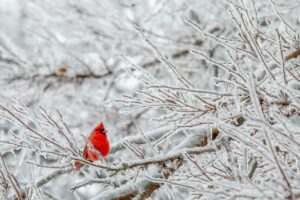
What birds come to feeders in Pennsylvania in winter?
There are many birds that visit feeders in Pennsylvania in winter. Following are some of the most common. There are many other birds that come to feeders in summer, or are found in backyards but not feeders. You can read about them in my article: The most common backyard birds in Pennsylvania. I’ll link to this article again in the related articles section at the conclusion of this page.
The following summaries show a photo of a common winter feeder bird, tell a little about where they are found, and what they look and sound like. Then I tell what foods you can use to attract them and what kind of feeders they like.
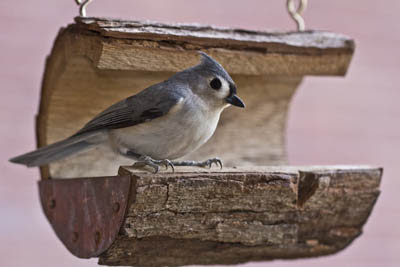 |
| Tufted Titmouse Image by anne773 from Pixabay |
Tufted Titmouse:
These relatives of the chickadee will be sure to visit your feeders.
They are found in woodlands throughout the eastern United States and all of Pennsylvania.
They are stocky with a big head and ample tail. They are mostly gray above and paler white below. They have some black feathers around the eye and on the forehead. The wispy crest isn’t always very noticeable.
Birds sing a whistled Peter Peter Peter song and have various whistled notes and husky chickadee-like calls.
Tufted Titmouses love to eat black oil sunflower seeds at hopper and tube feeders. They love suet, too.
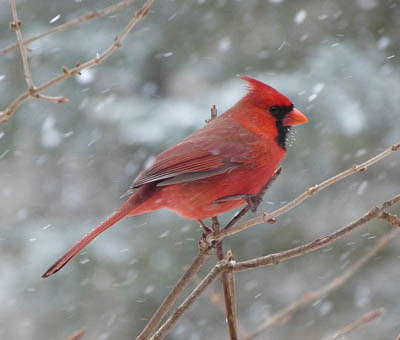 |
| Northern Cardinal Image by tlparadis from Pixaby |
Northern Cardinal:
These are perhaps the favorite feeder birds in the eastern, central, and southern United States. They are found throughout the year in Pennsylvania.
These fairly large songbirds sport a nifty crest and long tail. Males are bright red with black feathers around the bill, eyes, and throat. The bill is heavy and orange. Females are duller brown, but obvious.
They sing throughout the year, a loud whistled birdy birdy birdy.
Northern Cardinals like larger seeds including sunflower and safflower seeds and nuts. They like platform or larger hopper feeders.
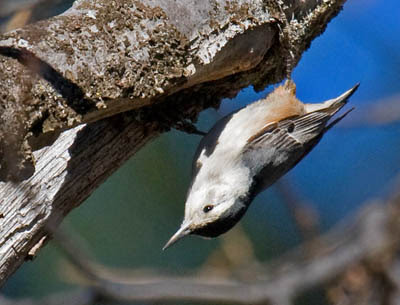 |
| White-breasted Nuthatch Photo by Greg Gillson |
White-breasted Nuthatch:
Crawling over around and on the underside of branches or even headfirst down the trunk, nuthatches are a favorite feeder bird across the United States and southern Canada. These birds are found throughout the year in Pennsylvania.
They are plump and large-headed with a stub of a tail and long pointed bill. They are blue above with a black cap. They are white below, including all the way up on the face. They have a touch of rusty color between the legs.
White-breasted Nuthatches love black oil sunflower seeds from tube or hopper feeders. They also love suet.
 |
| Dark-eyed Junco Photo by Greg Gillson |
Dark-eyed Junco:
Flocks of these little sparrows at your feeder indicate that winter is here!
These birds of conifer forests nest from Alaska and across Canada in the mountains of the West and Northeast. They breed in summer in the mountains of Pennsylvania, especially in the north and south-central parts of the state, and winter throughout.
They are tiny and rather plump with a medium-length tail that constantly flashes white edges. They are mostly gray above, females slightly brown on the back. The belly is white. They have a small pink bill.
Their spring song is a musical trill on one pitch. They constantly smack and twitter as they call in flocks in winter.
Dark-eyed Juncos forage on the ground and will eat the smaller seeds in the cheap mixed bird seed blends. They will readily use a platform feeder.
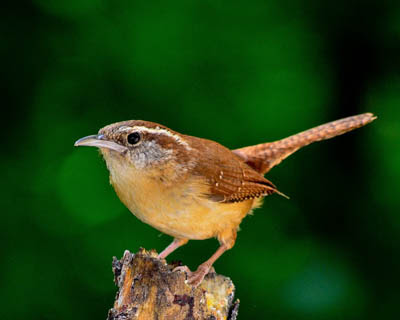 |
| Carolina Wren Image by theSOARnet from Pixabay |
Carolina Wren:
These are common residents in brushy backyards. They are found throughout the East and Southeast. They are found year-round throughout Pennsylvania.
Kind of chunky. They have a long active tail. The flat head sports a long thin curved bill that comes to a sharp point. They are brown above, buff below, with a long white eyebrow stripe. The wings and tail are barred with fine black marks.
They sing throughout the year, a musical teakettle teakettle teakettle.
Carolina Wrens visit winter feeders for suet.
 |
| Song Sparrow Photo by Greg Gillson |
Song Sparrow:
These birds are more common in marshes and tangles, but also live in backyards that are landscaped with larger thick bushes. They occur in singles and pairs.
They are resident in coastal Alaska, the West, across mid-latitudes of the United States and mountains of the eastern United States. They summer across Canada and the northern United States. In winter, birds of Canada and north-central U.S. migrate south so that they are found throughout the United States. In Pennsylvania they can be found throughout the state all year long.
They have a round body, round head, and longer tail with a round tip. They are gray and brown with darker brown streaks. The breast is heavily streaked that usually comes to a central spot on the upper breast.
They have a complex trilled song and a chimp call.
Song Sparrows will feed on platform feeders and sometimes hopper feeders. They will eat mixed bird seed. They often spend most time on the ground searching for food under bushes.
 |
| Black-capped Chickadee Photo by Greg Gillson |
Black-capped Chickadee:
These round balls of fluff are favorites at bird feeders.
They are resident from Alaska, across Canada, and widely across the northern United States. In Pennsylvania they live year round in most areas, but are absent from the southeast part of the state.
They are round with a big head and hardly any neck. They have a long thin tail that flogs about. They are gray above and pale buff below. The white face is edged with an extensive black cap and large black throat.
Calls are a slightly hoarse chickadee-dee-dee.
Black-capped Chickadees love black oil sunflower seeds grabbed one at a time and taken away to pound open and eat. They eat from tube and hopper feeders.
 |
| House Finch Photo by Greg Gillson |
House Finch:
These are common feeder birds are found in flocks throughout most of the United States.
They are resident across the United States and live year round in Pennsylvania.
They are dusty gray with brown streaks above. Below the pale underparts are heavily streaked with wide brown lines. Females are quite non-descript, but males have bright red on the forehead, upper breast, and rump.
The males have a rapid cheerful song of high notes ending with a nasal wheer. The calls given by all birds are two-parted chirps: cheer-ip, given constantly.
House Finches love black oil sunflower seeds at tube feeders. They also will eat Niger seed from special “finch feeders” or “thistle socks.”
 |
| Downy Woodpecker Photo by Greg Gillson |
Downy Woodpecker:
These are the smallest woodpeckers in North America, only 6 inches from bill tip to tail tip.
They are found across Alaska and Canada and most of the United States except for the Southwest deserts. They are found throughout the year in all of Pennsylvania.
They are stout with a short pointed tail. The head is large with a small pointed chisel-shaped bill. They are white below. Their shoulders and wings are black with white spots. The back is white. The tail has white outer tail feathers. The face is striped black and white. Males show a small red spot on the nape.
Calls are a sharp pik, run together into a dry rattle that descends as a song in spring.
Downy Woodpeckers love suet and readily come to backyard feeding stations that offer it or crushed nuts.
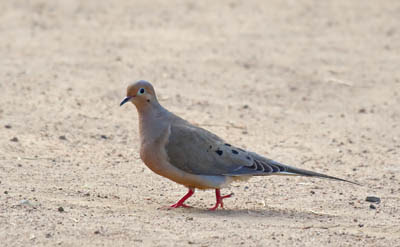 |
| Mourning Dove Photo by Greg Gillson |
Mourning Dove:
These large feeder birds are familiar to all.
They are found from southern Canada, throughout the United States and Mexico. In winter birds in Canada and northern Great Plains migrate south. These birds are found throughout the year in Pennsylvania.
They are plump with a small round head on a thin neck. They have a long pointed tail. They are brown above, paler below, with a slightly pinkish tinge on the breast. The bill is slim and short.
Their calls are a sad mellow cooing: boo hoo-hoo hoo.
Mourning Doves love all sorts of seeds and grains and nuts at your feeder. They prefer a platform feeder but will squeeze onto a hopper feeder, too.
 |
| Blue Jay Image by skeeze from Pixabay |
Blue Jay:
This brash bird of hardwood forests and residential areas is found throughout the central and eastern United States and southern Canada. They are found throughout the year in Pennsylvania.
Blue above and white below, they have big white wing patches and white tail corners. The white face has a blue crest above and a black necklace below.
Varied calls include harsh jay jay jay and whistled wheedle notes.
Blue Jays are not always welcome at feeders where they may aggressively chase off other birds. They may take large batches of sunflower seeds away to bury them for winter. They love peanuts and other nuts from platform or hopper feeders.
 |
| Red-bellied Woodpecker Image by skeeze from Pixabay |
Red-bellied Woodpecker:
This is a common backyard throughout the East and central states. They live year-round in all of Pennsylvania.
As with all woodpeckers, they are stocky with a short stiff pointed tail and large head. They have a long strong chisel-shaped bill. They are pale gray below and on the head. The back is finely striped with black and white. The back of the head is read, more extensive on the male.
They give a loud rolling churr call.
Red-bellied Woodpeckers will visit platform and large hopper feeders to eat sunflower seeds and nuts, including peanuts. They love suet, too.
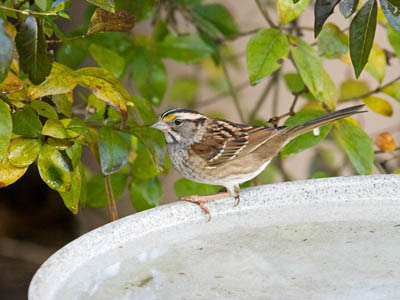 |
| White-throated Sparrow Photo by Greg Gillson |
White-throated Sparrow:
These large sparrows spend much time on the ground or in small trees.
In summer they are found across Canada east of the Rocky Mountains, and just the extreme edge of the United States in the Midwest and East. In the winter they are most common in the south and southeastern United States, much less common in the West. In Pennsylvania they live year round in the higher elevations of the northeastern part of the state. During winter they are found throughout Pennsylvania.
These are fairly big sparrows with long tails. They are brown striped with darker brown above. Below they are gray, including the face. Obvious head markings include a well-marked white throat and yellow spot in front of they eye. The eyebrow stripe may be white or tan.
In summer they whistle Ole Sam Peabody. Their call is a quite loud sharp pink.
White-throated Sparrows visit hopper feeders to feed on black oil sunflower and other mixed seeds. You may note them at dawn and dusk more than mid-day.
Wrapping Up
Two types of feeders will do well in Pennsylvania. Hopper feeders with wide trays will attract the most variety of birds. Fill these with bird seed that includes a good amount of sunflower seeds, white proso millet, and crushed nuts. That way you will attract the sparrows, Cardinals, doves, and titmouses.
Because of snow, you will want to look for a hopper feeder with a large overhanging roof. This will keep snow off the food, but also protect the seed in the feeder tray from rain or snow melt.
You will want a tube feeder filled with black oil sunflower seeds. These will attract House Finches, Black-capped Chickadees, Tufted Titmouses, and White-breasted Nuthatches.
If you are inclined, I would also recommend two more feeders. A low platform feeder will attract the ground feeding juncos, sparrows, and Mourning Doves. These birds will eat the cheaper mixed bird seed that other birds don’t like.
Finally, a suet feeder can bring in other birds that seed will not attract. Carolina Wrens, woodpeckers, and nuthatches will be especially attracted to suet. Try different varieties. Suet with seed will attract all the other birds from the seed feeders. But nuts and fruit may be more attractive to the woodpeckers and nuthatches.
You may not think of it, but in freezing dry winter weather, or heavy snow, birds need water to drink. You may consider buying a bird bath heater to help provide open water for the winter birds you care for in your backyard.
Frequently Asked Questions
Where do Pennsylvania birds go in the winter?
Pennsylvania birds take various routes during the winter depending on the species and their individual preferences. Here’s a breakdown:
Migrators:
- Long-distance: Many songbirds, like warblers, tanagers, and vireos, undertake epic journeys to Central or South America, escaping the harsh winter conditions. Common examples include American Redstarts, Yellow Warblers, and Indigo Buntings.
- Shorter hops: Some species migrate southward within North America, finding milder climates in the southern United States, Caribbean, or Mexico. Cardinals, Robins, and Blue Jays fall into this category.
Stay-at-homes:
- Year-round residents: Several bird species are perfectly adapted to Pennsylvania’s colder months and stick around throughout the year. These include chickadees, nuthatches, woodpeckers, owls, and hawks.
- Winter visitors: Some birds from the far north find Pennsylvania’s winter relatively mild compared to their arctic breeding grounds. These include Snow Buntings, Pine Siskins, and Redpolls, adding a touch of variety to the winter bird community.
Do robins stay in PA for the winter?
The answer to whether robins stay in Pennsylvania for the winter is a bit complex and depends on several factors:
Some robins do in fact stay in Pennsylvania during the winter, particularly in the western and southern parts of the state where temperatures tend to be milder.
However, the majority of robins migrate south to escape the harsh winter conditions and limited food availability. They typically migrate to the southern United States, Mexico, Central America, and even northern South America.
Here’s a breakdown of the factors that influence whether a robin will stay in Pennsylvania or migrate:
- Temperature: Colder winters will push more robins southward, while milder winters might encourage some to stay put.
- Food availability: Robins rely on fruits, berries, and insects for food. If these resources are scarce in winter, they’ll be more likely to migrate.
- Individual variations: Some robins are simply more adventurous or have stronger constitutions than others, leading to differences in their migration behavior.
So, while you might still see some robins around in Pennsylvania during the winter, especially near evergreen trees and other sources of food, the majority will have flown south for warmer weather and abundant food.
What birds don’t migrate in PA?
Many bird species call Pennsylvania home year-round, defying the urge to migrate south for warmer weather. These hardy residents add a splash of life to the winter landscape and provide an opportunity to observe their fascinating adaptations to colder climates. Here are some of the most common non-migratory birds in Pennsylvania:
Woodpeckers:
- Downy Woodpecker: These small black and white birds with a white belly are familiar backyard visitors, drumming on trees and searching for insects under bark.
- Hairy Woodpecker: Slightly larger than the Downy Woodpecker, with a black back and white stripes, they play a vital role in controlling insect populations.
- Pileated Woodpecker: The largest woodpecker in Pennsylvania, readily identified by its red crest and loud drumming calls, excavates large holes in trees for food and nesting.
Chickadees and Nuthatches:
- Black-capped Chickadee: These curious birds with black caps and bibs flit through trees, uttering their distinctive “chick-a-dee” calls.
- Carolina Chickadee: Their yellow bellies and “dee-dee-dee” calls differentiate them from Black-capped Chickadees. Both species store food in hidden caches to access during winter.
- White-breasted Nuthatch: With their blue-gray upperparts and white undersides, these acrobatic birds climb headfirst down tree trunks, searching for insects and seeds.
Related Articles:
The most common backyard birds in Pennsylvania
My recommended bird feeder setup
Bird seeds that attract the most birds






